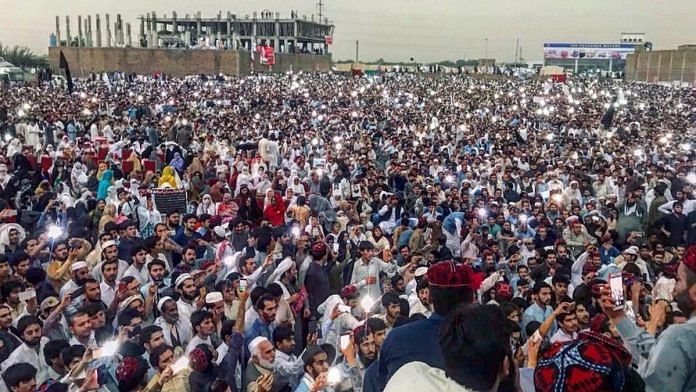Pakistani Prime Minister Imran Khan spent a lot of years in the political wilderness. After nearly 17 years of struggle, he achieved his first electoral success when his party, Pakistan Tehreek-e-Insaf (PTI), won a number of seats in the country’s northern province, Khyber Pakhtunkhwa (KP). His first political victory came on the back of campaigning against US drone-warfare and for the legitimate rights of the tribal-Pashtun population.
It is, then, deeply ironic, that with Khan as prime minister today, a momentous protest movement led by Pashtuns, Pashtun Tahafuz Movement (PTM), is currently shaking Pakistan’s military-political establishment in Islamabad over the alleged killing of one its activist on 3 February.
As the movement is back in focus, ThePrint takes a look at the history of PTM.
Origins of PTM
The Pashtun Tahafuz Movement emerged in January last year, when a young Pashtun, Naqeebullah Mehsud was killed during an extrajudicial police encounter in Karachi. Soon after, pictures of Naqeebullah with his child flooded social media among the Pashtun.
At that point, a young student activist, Manzoor Pashteen was running the “Mehsood Tahafuz Movement”, asking for the rights of those killed and displaced in South Waziristan due to the army’s counterinsurgency against the Pakistani Taliban.
Naqeeb’s killing acted as the trigger. Headed by Pashteen, a protest march was facilitated where Pashtuns walked from Dera Ismail Khan in KP to Islamabad. As the march steered ahead, more and more grieving Pashtuns joined the March.
On reaching Islamabad, they conducted a mass demonstration outside the Islamabad Press Club. Politicians from all opposition political parties joined their demonstration.
Interestingly, even Imran Khan was a part of the demonstration.
What started as a movement seeking justice for Naqeeb quickly morphed into the Pashtun Tahafuz Movement, and its demands evolved to seeking justice for all of Pashtuns.
PTM’s demands even included recovery of missing persons, ending harassment of Pashtuns at checkpoints, clearing of landmines, and setting up a Truth and Reconciliation Commission.
What was unique about PTM was that they were targeting the militants and the military establishment at the same time. Most protests in Pakistan’s recent history have pussyfooted about directly taking on the Army.
In what has come to be known as their motto now, PTM rallies were marked by incendiary slogans such as “Yeh jo dehshatgardi hai, iske peeche wardi hai (The ones responsible for terrorism are the ones in uniform).” Another Pashto slogan, which became their defining line, was “Da sangaazadi da? (What kind of freedom is this?).”
Also read: Imran Khan will continue Pakistan’s ‘one step forward, one step back’ approach to Israel
State’s reaction
The army and state’s reaction was along expected lines.
Pakistani Army chief Qamar Javed Bajwa called the protests “engineered”. PTM was not only blocked from getting any kind of media coverage, the state propped up anti-PTM movements which were given a lot of media coverage.
It also carried out a complete crackdown on peaceful PTM supporters and arrested its leaders, including Pashteen. Additionally, their supporters including activists, academics, and average citizens were also arrested.
Writing for The Diplomat, scholar Hussain Nadeem argued that Pakistani thinking when reacting to such crises is deeply securitised. So, given that PTM was radical in its tactics and using anti-army slogans, it was enough for the army to provide its knee-jerk violent reaction to the protests.
Surge in PTM’s momentum
A wave of hard-handed reactions by the state against PTM has made the international community notice of late.
Recently, the death of professor and PTM activist Arman Luni sparked PTM protests across the country. PTM leaders alleged that he was killed at the hands of the police during a peaceful sit-in in Balochistan’s Loralai region, where people had come to protest against last month’s terror attack in the region.
Over the next few days, two brothers were arrested and charged with sedition for protesting against Luni’s death. On 5 February, 20 PTM activists, including well-known PTM activist Gulalai Ismail, were arrested in Islamabad, whilst they were protesting against the alleged killing of Luni.
Following the death of Luni, Afghanistan President Ashraf Ghani tweeted about how his government is “concerned” about violence perpetrated against protesters who have been peacefully protesting in KP and Balochistan.
Ghani’s tweet evoked sharp reactions from Pakistani government officials, further deteriorating an already fragile relationship between Pakistan and Afghanistan.
In a recent opinion column for at the New York Times, PTM leader Pashteen wrote, “We held numerous sit-ins and protests and continued to hope that Pakistan’s leaders would try to address our concerns. Instead, they responded with intimidation and violence.”
What is responsible for the state of Pashtuns?
In his piece for the Diplomat, Nadim wrote that with the advent of the Afghan-Soviet War, and the involvement of Pakistan, Pashtuns had to deal with fear right from the 1970s.
Later on from 2001, after the US attacked Afghanistan, al Qaeda and Taliban found refuge in North Waziristan. Soon enough, they became the region’s most powerful actors. By 2009, Pakistan’s Peoples Party allowed Sharia law to be applied in Malkhand (KP) and handed over the region to Pakistani Taliban.
Following the 2014 Peshawar attack on a school, the army finally took on Pakistani Taliban with a counterinsurgency operation.
With the end of counterinsurgency, when Pashtuns finally returned, they came back to ruins and razed villages. Furthermore, unused land mines had not been removed, which killed several Pashtuns.
Imran Khan was the first major representative of Pashtuni grievances. But his elevation to national politics meant that Pashtuns were again left to fend for themselves.
The ongoing movement is now seeking to fill that political vacuum.






